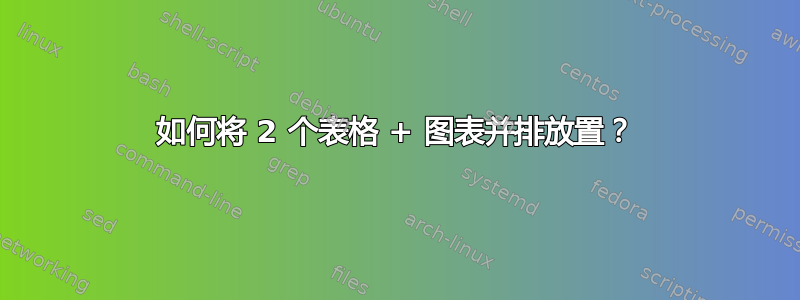
我是 Tex 的新手,我有一个问题。
这是我的代码:
\begin{table}[!htb]
\textbf{Gruppe 1:} \\\\
\begin{tabular}{l| r}
Student 1 & Student 2 \\\hline
$s1$ & $s2$ \\
$s3$ & $s4$
\end{tabular}
\\\\\\
\begin{tikzpicture}[main_node/.style={circle,fill=blue!20,draw,minimum size=1em,inner sep=3pt]}]
\node[main_node] (1) at (-1,0) {s1};
\node[main_node] (2) at (-1, -1.5) {s2};
\node[main_node] (3) at (1, 0) {s3};
\node[main_node] (4) at (1, -1.5) {s4};
\draw (1) -- (2) (3) -- (4);
\\\\
\end{tikzpicture} \\\\
\textbf{Gruppe 2:} \\\\
\begin{tabular}{l|r}
Student 1 & Student 2 \\\hline
$s1$ & $s3$ \\
$s2$ & $s4$
\end{tabular}
\\\\
\begin{tikzpicture}[main_node/.style={circle,fill=blue!20,draw,minimum
size=1em,inner sep=3pt]}][h!]
\node[main_node] (1) at (-1,0) {s1};
\node[main_node] (2) at (-1, -1.5) {s2};
\node[main_node] (3) at (1, 0) {s3};
\node[main_node] (4) at (1, -1.5) {s4};
\draw (1) -- (3) (2) -- (4);
\end{tikzpicture}\\\\
\textbf{Gruppe 3:} \\\\
\begin{tabular}{l|r}
Student 1 & Student 2 \\\hline
$s1$ & $s4$ \\
$s3$ & $s2$
\end{tabular}\\\\\\
\begin{tikzpicture}[main_node/.style={circle,fill=blue!20,draw,minimum
size=1em,inner sep=3pt]}]
\node[main_node] (1) at (-1,0) {s1};
\node[main_node] (2) at (-1, -1.5) {s2};
\node[main_node] (3) at (1, 0) {s3};
\node[main_node] (4) at (1, -1.5) {s4};
\draw (1) -- (4) (3) -- (2);
\end{tikzpicture}
\end{table}
我的问题是:Exercise 1.1.a)我想让Gruppe 1整个区块紧挨着Gruppe 2整个区块。该怎么做?
答案1
像这样?
您的问题不清楚,所以我猜上面的图片展示了您想要实现的目标:
- 在文本中你说的是两个表,但在代码中却是三个
- 从代码片段可以得出结论,图像位于表格下方
姆韦(最小工作示例)生成上述图像的方法是:
\documentclass[12pt,a4paper]{article}
\usepackage{tikz}
\usetikzlibrary{positioning}
\usepackage{tabularx}
\newcolumntype{C}{>{\centering\arraybackslash}X}
\usepackage{amsmath}
\begin{document}
\tikzset{
every node/.style = {circle,fill=blue!20,draw,minimum size=1em,inner sep=3pt},
node distance = 8mm and 12mm
}
\noindent
\begin{tabularx}{\linewidth}{CCC}
\centering
\textbf{Gruppe 1:}
\[
\begin{array}{l | r}
\text{Student 1} & \text{Student 2} \\
\hline
s1 & s2 \\
s3 & s4
\end{array}
\]
\begin{tikzpicture}
\node (n1) {s1};
\node (n2) [below=of n1] {s2};
\node (n3) [right=of n1] {s3};
\node (n4) [below=of n3] {s4};
%
\draw (n1) -- (n2) (n3) -- (n4);
\end{tikzpicture}
&
\textbf{Gruppe 2:}
\[
\begin{array}{l | r}
\text{Student 1} & \text{Student 2} \\
\hline
s1 & s2 \\
s3 & s4
\end{array}
\]
\begin{tikzpicture}
\node (n1) {s1};
\node (n2) [below=of n1] {s2};
\node (n3) [right=of n1] {s3};
\node (n4) [below=of n3] {s4};
%
\draw (n1) -- (n3) (n2) -- (n4);
\end{tikzpicture}
&
\textbf{Gruppe 3:}
\[
\begin{array}{l | r}
\text{Student 1} & \text{Student 2} \\
\hline
s1 & s2 \\
s3 & s4
\end{array}
\]
\begin{tikzpicture}
\node (n1) {s1};
\node (n2) [below=of n1] {s2};
\node (n3) [right=of n1] {s3};
\node (n4) [below=of n3] {s4};
%
\draw (n1) -- (n4) (n2) -- (n3);
\end{tikzpicture}
\end{tabularx}
\end{document}
答案2
如果我理解正确的话,您只想有两个组并排。
由于您的图像(不包括线条)相同,因此我还创建了一个pic使用tikz matrix来绘制它们的 。这避免了代码行的重复。
\documentclass[a4paper,11pt]{article}
\usepackage{tikz}
\usetikzlibrary{matrix}
\tikzset{
main_node/.style = {circle,fill=blue!20,draw,minimum size=1em,inner sep=3pt},
pics/mymatrix/.style={code={%
\matrix[matrix of nodes,
ampersand replacement=\&,
nodes={main_node},
column sep= 12mm,
row sep=8mm] {%
|[name=1]| {s1} \& |[name=3]| {s3}\\
|[name=2]| {s2} \& |[name=4]| {s4}\\
};
}},
}
\usepackage{array}
\renewcommand{\arraystretch}{1.2}
\begin{document}
\begin{table}[!htb]
\centering
\begin{tabular}{c@{\hspace{3em}}c}% <-- \hspace{3em} is the additional space between the two groups
\textbf{Gruppe 1:} &
\textbf{Gruppe 2:} \\
\begin{tabular}{l| r}
Student 1 & Student 2 \\\hline
$s1$ & $s2$ \\
$s3$ & $s4$
\end{tabular}
&
\begin{tabular}{l|r}
Student 1 & Student 2 \\\hline
$s1$ & $s3$ \\
$s2$ & $s4$
\end{tabular}
\\[5ex]% <-- additional space between the tables and the picture
\begin{tikzpicture}
\pic {mymatrix};
\draw (1) -- (2) (3) -- (4);
\end{tikzpicture}
&
\begin{tikzpicture}
\pic {mymatrix};
\draw (1) -- (3) (2) -- (4);
\end{tikzpicture}
\\
\end{tabular}
\vspace{4ex}% <-- additional space between the 1-2 groups and the 3
\begin{tabular}{c}
\textbf{Gruppe 3:} \\
\begin{tabular}{l|r}
Student 1 & Student 2 \\\hline
$s1$ & $s4$ \\
$s3$ & $s2$
\end{tabular}
\\[5ex]% <-- additional space between the tables and the picture
\begin{tikzpicture}
\pic {mymatrix};
\draw (1) -- (4) (3) -- (2);
\end{tikzpicture}
\\
\end{tabular}
\end{table}
\end{document}




